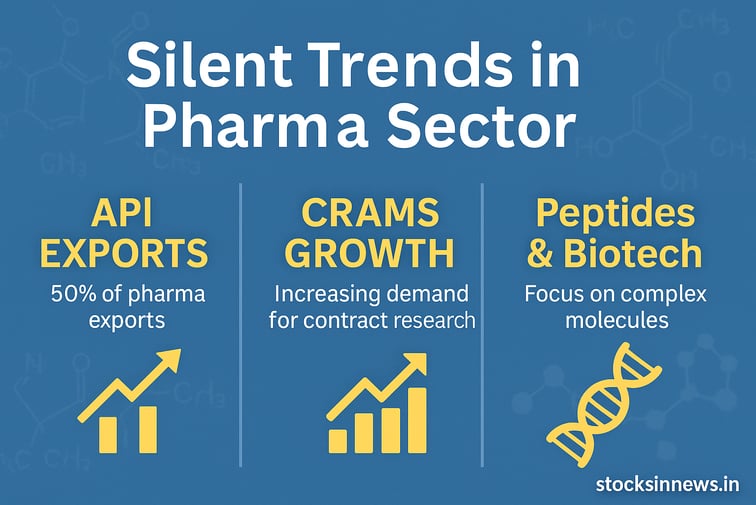Hidden Gems in Pharma Sector 2025 — 7 Smallcap Stocks Retail Investors Should Watch
SECTOR NEWS
Hidden Gems in Pharma Sector 2025 — Silent Trends Retail Investors Should Watch
Why Pharma’s Under the Radar — But Powerful
When the market buzzes about defence stocks, green hydrogen, or infra spending, pharma often feels boring. But some of India’s best smallcaps have quietly built wealth for patient investors in this space.
What makes it special? Unlike big generic giants that struggle with price wars and patent cliffs, niche pharma players in APIs, CRAMS, and peptides stay resilient. Many of these companies operate in tight global supply chains, backed by strict regulatory approvals that create high entry barriers.
The silent trend is clear: India’s role as a reliable alternative to China for key molecules and specialty APIs is stronger than ever. If you’re a retail investor who wants a small slice of consistent compounders, these hidden gems deserve a closer look.
Suven Pharmaceuticals: Quiet CRAMS Leader
Suven focuses on contract research and manufacturing — an area global pharma giants increasingly outsource. Its strength lies in complex molecule discovery services, which are costly to replicate.
Over 60% of Suven’s revenue comes from exports. Despite market volatility, it’s maintained margins around 25% — a rare feat for a smallcap. Its R&D edge makes it one of the more reliable mid-sized CRAMS players.
Neuland Laboratories: Peptide & Complex APIs
Neuland’s specialty is manufacturing complex APIs like peptides. These are not generic pills you’ll find in every chemist — they’re technically challenging, regulated heavily, and tough for new entrants.
In the last few years, Neuland has received consistent USFDA and EU approvals, expanding its export footprint. Its track record makes it a trusted partner for global companies that need quality at scale.
Marksans Pharma: Focused on Generics & Cash Flow
Marksans is not exactly an unknown name, but it often gets overlooked compared to bigger listed peers. Its edge is in OTC and prescription generics for regulated markets like the US and UK.
What’s attractive? About 70% of revenue comes from these markets — a sign of trust. Plus, low debt and stable cash flows add comfort. For retail investors, Marksans shows that small generic players can survive by picking less crowded therapeutic segments.
Laurus Labs: The Biotech Transition
Savvy investors already know Laurus for its bulk API business. But what keeps it in the “silent trend” zone is its shift into biotech APIs and formulations — a higher-margin space that builds durability.
With ~25% CAGR growth over five years and a robust R&D pipeline, Laurus is slowly becoming more than a commodity bulk supplier. This transition could quietly compound for patient investors who ignore daily noise.
Lincoln Pharmaceuticals: Latin America Play
Lincoln is a small player that focuses on niche therapeutic areas like anti-malarial, gynecology, and wellness. It’s expanding exports to new geographies — especially Latin America and Africa.
Though only ~15% of revenue comes from exports today, recent filings show that new registrations and contracts are adding momentum. A consistent improvement in operating margins signals management discipline, which matters for smallcaps.
Anuh Pharma: Antibiotics API Specialist
Anuh doesn’t make big headlines but has quietly retained a strong foothold in antibiotics APIs — a segment that China once dominated. Its balance sheet looks healthy, with promoters holding over 70% stake and consistent dividends.
With more global buyers looking for China+1 sources, Anuh is positioned to benefit — though currency swings and export dependency can still cause bumps.
Gland Pharma: Injectable Niche
Injectables are a complex niche with high compliance standards — and Gland excels here. Its USFDA-approved plants and strong international client base give it a real edge.
While recent quarters have seen ups and downs, its long-term order book and stickiness in high-barrier markets make it a stock worth watching in any pharma “hidden gems” basket.
Why These Pharma Picks Stand Out
So why do these companies matter when the broader pharma index feels slow?
They’re in segments with high entry barriers.
They rely on exports — giving them a natural hedge.
Promoter holdings are often high and steady, signalling confidence.
Many invest heavily in R&D — the real engine for long-term wealth.
Risks You Can’t Ignore
Hidden gems come with hidden risks too. Global regulatory approvals can be pulled anytime — one USFDA warning letter can hit earnings for quarters. Many of these players also have high export exposure, so INR-USD swings affect profits. And smallcaps naturally swing 20–30% in choppy markets — so diversification is key.
Takeaway for Retail Investors
Hidden pharma compounders won’t double overnight. But they often outperform when the broader market goes sideways. If you’re betting on long-term themes like China+1 and global outsourcing, allocating a small basket to niche API, CRAMS, or biotech players can balance your largecap-heavy portfolio.
Just remember: Do your own research, watch quarterly results, and never bet the house on one stock.
FAQ
Q: What is CRAMS in pharma?
A: Contract Research and Manufacturing Services — global big pharma pay Indian players for R&D and production.
Q: How should retail investors approach these stocks?
A: As trends to watch — not tips to blindly buy. Always consult a SEBI-registered advisor and build a diversified basket.
Author :
Written by Nitin Kumar Gullianya, B.Tech — 15 years of investing experience. Sources: NSE filings, company reports.
Standard Disclaimer:
This is for informational purposes only and not investment advice. always consult your sebi registered financial advisor before taking any investment decision

